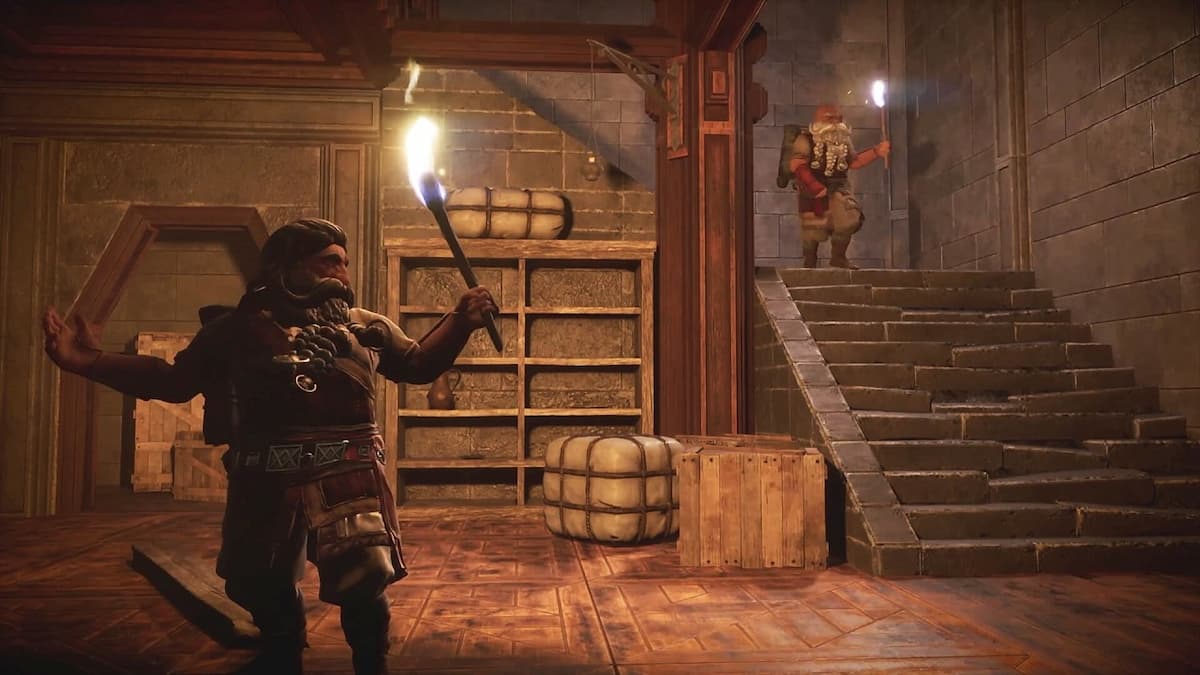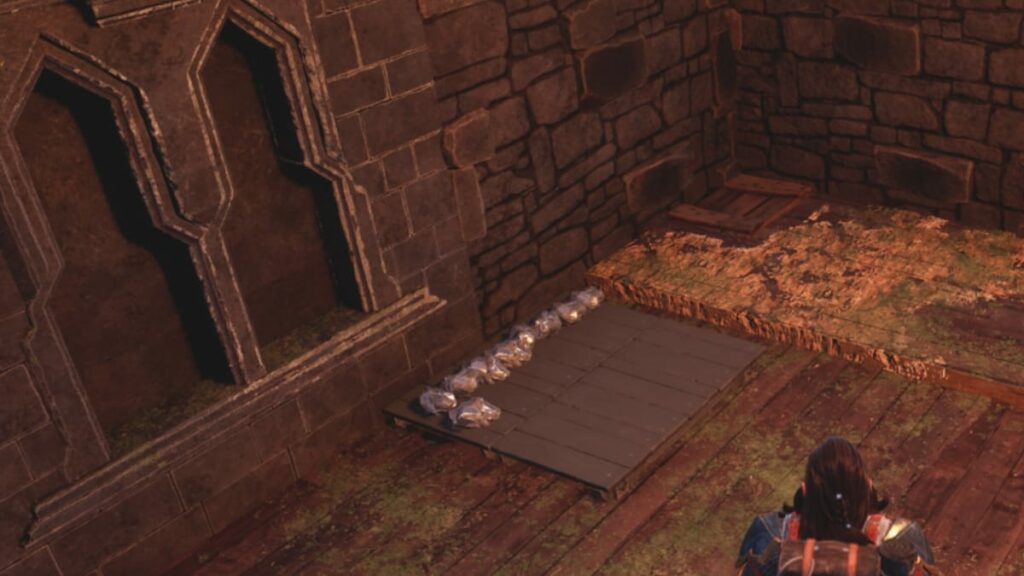
Image source: North Beach Games
As you’d expect in a survival game, resources are your lifeline in The Lord of the Rings: Return to Moria. They’re essential for crafting weapons, armor, and other necessities. Here we’ll provide a brief overview of what resources are and how they work, later detailing where to find each.
Resources in Lord of the Rings Return to Moria

As we explained in our Return to Moria beginners guide, most resources are easily visible, like wood scraps on the ground or iron veins in walls. However, there are less apparent sources too. Almost everything you encounter in the game can be broken down into basic resources.
You can chop down trees, demolish old buildings, and even collect random resources from defeated Goblins. As you venture into more challenging areas, discovering nearby resources becomes vital, making it worthwhile to explore unusual sources.
Certain resources are mainly concentrated in specific locations. For example, Elvish wood can be found in well-lit areas with Wizard markers that highlight Elven power. Exploration plays a significant role in the game.
When searching for ore to craft specific items, it may not always be clear what to look for. You’ll need to explore and collect everything you come across to determine your needs. For example, bronze ingots don’t come from bronze ore but rather from tin ore, so don’t be misled by the color of the ore veins. The map can assist in this regard, displaying previously found veins as long as you’ve mined them slightly. While the ore doesn’t respawn, this feature aids in narrowing your search, especially when you’re in a hurry to return to your base or evade enemies.
Resource Renewability, Explained
Before diving into the specifics of each resource, let’s kick off by answering a popular question: Are resources renewable in Return to Moria? The answer varies for different resources.
- Renewable Resources: Certain resources, such as wood and vegetables, can regrow over time, and you can even set up farms to expedite their regeneration.
- Non-Renewable Resources: Unfortunately, not all resources regenerate. Items like iron and Hero’s Tokens are finite, meaning you should allocate them carefully.
The following sections will list all the resources available in the game and where you can find them. That way, if you’re wondering how to get Iron ore or Black Diamond in Return to Moria, or really particular resource, you can simply use this as a reference. Of course, we will likely provide more in-depth answers to these questions in separate guides if we see people searching.
All Return to Moria Resource Locations
Common Resources
- Amber: Obtain by digging up Coal Veins throughout Moria.
- Amethyst: Found in The Lower Deeps.
- Aule Blooms: Can be found growing in The Elven Quarter in The Western Halls.
- Bat Droppings: Acquire by killing Bats in The Lower Deeps.
- Biteweed: Gather from the large Orc Camp at the end of The Western Halls.
- Black Diamond: Obtain by looting Orcish Chests and killing Bolgakh in The Western Halls. Used to craft map stones.
- Blazeshrooms: Can be found growing on the ground in The Lower Deeps.
- Bones: Acquire by killing Orcs in The Lower Deeps.
- Cabbages: Find them growing in The Elven Quarter in The Western Halls.
- Cave Honey: Harvest it from beehives concealed within barrels throughout Moria.
- Coal: Mined using a simple Pickaxe. Plenty to be found in the Elven Quarter.
- Chitin: Obtain by killing Mothes in The Lower Deeps.
- Metal Fragments: Dropped by orcs. Used to repair equipment.
- Rezin: Mined in the Lower Deeps of the Mines of Moria. Look for orange hue, found in Ihraz Granite veins.
Gemstones
- Citrine: Mine from Iron Veins throughout Moria.
- Garnet: Mine from Tin Veins throughout Moria.
- Iolite: Obtain by mining Star Metal Veins throughout Moria.
- Onyx: Obtain by mining Silver Veins in The Lower Deeps.
- Sapphires: Can be found in The Lower Deeps.
- Topaz: Find in The Darkest Deeps.
- True-Quartz: Obtain in some caves in The Lower Deeps and at the top of The Crystal Descent.
Precious Metals
- Gold Coins: Obtain by looting Buildings, Orcish chests, killing Orcs, and killing bosses throughout Moria.
- Iron Ore: Mine from Iron Veins throughout Moria (use it to craft steel ingots)
- Silver Ore: Mine from Silver Veins in The Lower Deeps.
- Star-Metal Ore: Can be found in The Angry Caverns.
- Tin Ore: Obtain by mining Tin Veins throughout Moria, with greater quantities in The Lower Deeps.
Vegetation and Crops
- Sunions: Find them on the ground in The Western Halls.
- Sunken Moss: Acquire on the ground in The Lower Deeps.
- Ubasam Wood: Get it by destroying large purple tree-like mushrooms and small purple mushrooms in The Lower Deeps — full walkthrough here.
- Bat Droppings: Necessary to set up a farm to grow crops. Found in the Crystal Descent during the nighttime.
Craftable Resources (Need Loom)
- Hide: Acquire by killing larger animals such as Cave Bears and Hriwara throughout Moria, or craft it at a Loom from Hide Scraps.
- Hide Scraps: Gather by killing smaller animals such as Wolves throughout Moria.
- Numenorian Cloth: Craft at a Loom.
- Leather: Craft at Loom.
Rare and Unique Resources
- Elbereth’s Blessing: Harvest it from an elven statue in The Elven Quarter in The Western Halls.
- Ironwood: Get it in Dwarrowdelf.
- Mountain Potatoes: Find them near light and water in The Lower Deeps.
- Ihraz Granite: Mine it in The Lower Deeps. Used for repairing statues (midway through the game).
- Elven Wood: Obtain by chopping down trees growing in The Elven Quarter in The Western Halls.
- Sunstone: Mined from the Barazinbar and The Darkest Deeps area (requires Tier 4 Pickaxe). Also a random drop from the Troll King.
- Annuminas Spices: Annuminas Spices are spices that are found in jars and barrels. They are used to add flavor to food and to craft some potions.
- Gundabad Slag: Gundabad Slag is a byproduct of the smelting process used by Orcs to extract metal from ore and can be used to craft some weapons and armor. Slay Orcs of Orcs of Gundabad (10%) drop rate.
- Khudzul Oats: Khudzul Oats are a type of grain. Harvested from the ground (Beyond) or from old Brewing equipment.
- Mithril: Used in the late game, harvested via dragon scales.
- Scales: Obtained from larger animals such as Drakes and Fell Beasts in Beyond.
- Khazad Stone: Less a resource and more an item, this isn’t something you need to use manually. It’s tied to the story. Full item walkthrough here.
10 Important Return to Moria Resources You Should ALWAYS Keep in Stock
Return to Moria is a survival game like any other, meaning that the entire gameplay loop is focused on farming resources. But there are definitely some resources worth holding onto more than others. Here are our picks:
- Natural Fiber: Found in spider lairs or abandoned structures, this is used to build rope ladders for navigating vertical environments.
- Resin: Located in the Lower Deeps, resin turns hide scraps into hide on a loom and is used in building cooking equipment like Roasting Pits.
- Bat Droppings: Necessary for setting up farms for crop growth, supplementing food supplies.
- Ihraz Granite: A key crafting component found in the depths, replacing stone in many deposits. It’s crucial for repairing statues and unlocking new recipes.
- Mithril: A rare metal obtained late in the game, used in crafting high-end tools and equipment.
- Elven Wood: Found in the Elven Quarter, it’s essential for various applications due to its high usage rate.
- Ubasam Wood: Sourced from fungi in the Lower Deeps, used in miscellaneous recipes.
- Metal Fragments: Dropped by orcs and broken barrels, these are important for repairing equipment.
- Black Diamond: Found in Orc chests, vital for crafting Map Stones for fast travel and repairing major progression structures.
- Coal: The most important resource, used as fuel and in crafting essential materials like steel ore.
How to Expand Your Inventory
If you’re wanting to lug about huge quantities of resources, you’ll want to learn how to increase your inventory size. To do so you’ll need to craft an “Adventurer’s Pack” using a workbench and eight hides. To obtain hides, you can hunt bears or hriwara. The workbench, crucial for crafting the adventurer’s pack, is created from a recipe you’ll receive after discovering elven wood for the first time. This typically happens in the Elven Quarters, so you’ll need to progress to that area to increase your inventory space. The adventurer’s pack provides an additional 25 inventory slots.
Now that you have a solid overview of resources in The Lord of the Rings: Return to Moria, you should be nicely prepared for your survival and crafting needs in the treacherous depths of Moria.





